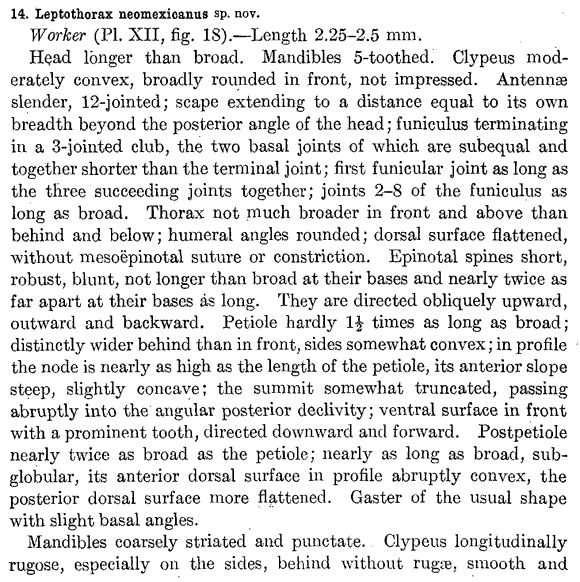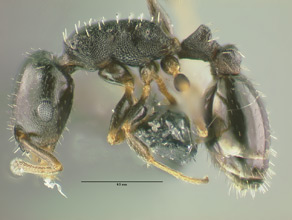- Identification
- Ants of the genus Temnothorax are small, with a head that is elongate relative to their mesosoma, and have an 11 or 12 segmented antenna that ends in a 3 segmented club. The mesosoma has no, or only minor, depressions along its dorsal surface and the propodeum either bears two small tooth-like projections or two true spines.
- Temnothorax neomexicanus workers are small black or dark brown ants with a 12 segmented antenna and short propodeal spines. Standing hairs are sparse but those that do occur are silvery white and subclavate. This species is most similar to Temnothorax tricarinatus but this other species has longer and better developed propodeal spines.
- Biology
- Modified from Mackay (2000): Nests in open, dry grassy areas, in Ponderosa pine forests, or even in desert areas, under rocks or in soil. Nests are monogynous. Cole (1954) found ground nests were marked by a hole in the ground and occasionally had a light, asymmetrical scattering of fine soil around the entrance.
- Distribution
- Range
- United States and Mexico. Nevada, Utah, Colorado, Arizona, New Mexico, Texas and Chihuahua.
- Navajo Reservation Records
- Collection records being processed.
- Etymology
- Geographic. The type specimens were collected in New Mexico.


- Literature
- MacKay, W. P. 2000. A review of the New World ants of the subgenus Myrafant, (Genus Leptothorax) (Hymenoptera: Formicidae). Sociobiology. 36:265-444.
- Cole, A. C., Jr. 1954. Studies of New Mexico ants. X. The genus Leptothorax (Hymenoptera: Formicidae). Journal of the Tennessee Academy of Science. 29:240-241.
- Wheeler, W. M. 1903. A revision of the North American ants of the genus Leptothorax Mayr. Proceedings of the Academy of Natural Sciences of Philadelphia. 55:215-260.
- A note about these publications. The literature cited here is not meant to be an exhaustive list of papers published about this species.
Page authored by David Lubertazzi and Gary Alpert


